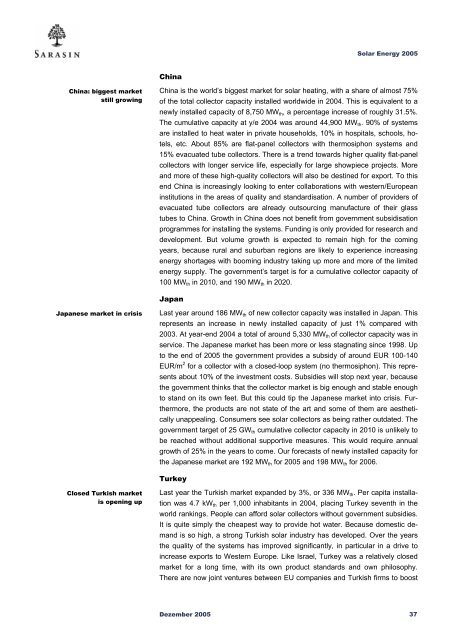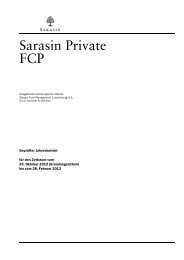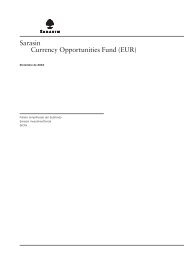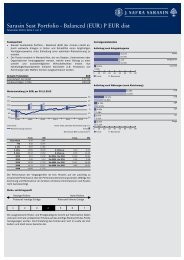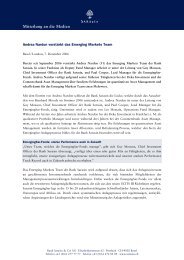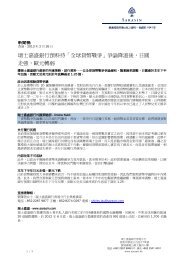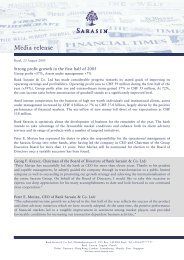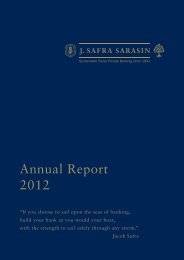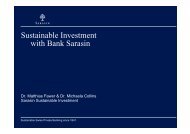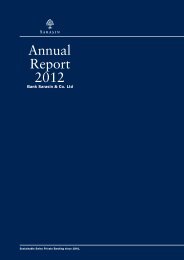Sustainability Report - Bank Sarasin-Alpen
Sustainability Report - Bank Sarasin-Alpen
Sustainability Report - Bank Sarasin-Alpen
Create successful ePaper yourself
Turn your PDF publications into a flip-book with our unique Google optimized e-Paper software.
Solar Energy 2005<br />
China<br />
China: biggest market<br />
still growing<br />
China is the world’s biggest market for solar heating, with a share of almost 75%<br />
of the total collector capacity installed worldwide in 2004. This is equivalent to a<br />
newly installed capacity of 8,750 MW th , a percentage increase of roughly 31.5%.<br />
The cumulative capacity at y/e 2004 was around 44,900 MW th . 90% of systems<br />
are installed to heat water in private households, 10% in hospitals, schools, hotels,<br />
etc. About 85% are flat-panel collectors with thermosiphon systems and<br />
15% evacuated tube collectors. There is a trend towards higher quality flat-panel<br />
collectors with longer service life, especially for large showpiece projects. More<br />
and more of these high-quality collectors will also be destined for export. To this<br />
end China is increasingly looking to enter collaborations with western/European<br />
institutions in the areas of quality and standardisation. A number of providers of<br />
evacuated tube collectors are already outsourcing manufacture of their glass<br />
tubes to China. Growth in China does not benefit from government subsidisation<br />
programmes for installing the systems. Funding is only provided for research and<br />
development. But volume growth is expected to remain high for the coming<br />
years, because rural and suburban regions are likely to experience increasing<br />
energy shortages with booming industry taking up more and more of the limited<br />
energy supply. The government’s target is for a cumulative collector capacity of<br />
100 MW th in 2010, and 190 MW th in 2020.<br />
Japan<br />
Japanese market in crisis<br />
Last year around 186 MW th of new collector capacity was installed in Japan. This<br />
represents an increase in newly installed capacity of just 1% compared with<br />
2003. At year-end 2004 a total of around 5,330 MW th of collector capacity was in<br />
service. The Japanese market has been more or less stagnating since 1998. Up<br />
to the end of 2005 the government provides a subsidy of around EUR 100-140<br />
EUR/m 2 for a collector with a closed-loop system (no thermosiphon). This represents<br />
about 10% of the investment costs. Subsidies will stop next year, because<br />
the government thinks that the collector market is big enough and stable enough<br />
to stand on its own feet. But this could tip the Japanese market into crisis. Furthermore,<br />
the products are not state of the art and some of them are aesthetically<br />
unappealing. Consumers see solar collectors as being rather outdated. The<br />
government target of 25 GW th cumulative collector capacity in 2010 is unlikely to<br />
be reached without additional supportive measures. This would require annual<br />
growth of 25% in the years to come. Our forecasts of newly installed capacity for<br />
the Japanese market are 192 MW th for 2005 and 198 MW th for 2006.<br />
Turkey<br />
Closed Turkish market<br />
is opening up<br />
Last year the Turkish market expanded by 3%, or 336 MW th . Per capita installation<br />
was 4.7 kW th per 1,000 inhabitants in 2004, placing Turkey seventh in the<br />
world rankings. People can afford solar collectors without government subsidies.<br />
It is quite simply the cheapest way to provide hot water. Because domestic demand<br />
is so high, a strong Turkish solar industry has developed. Over the years<br />
the quality of the systems has improved significantly, in particular in a drive to<br />
increase exports to Western Europe. Like Israel, Turkey was a relatively closed<br />
market for a long time, with its own product standards and own philosophy.<br />
There are now joint ventures between EU companies and Turkish firms to boost<br />
Dezember 2005 37


